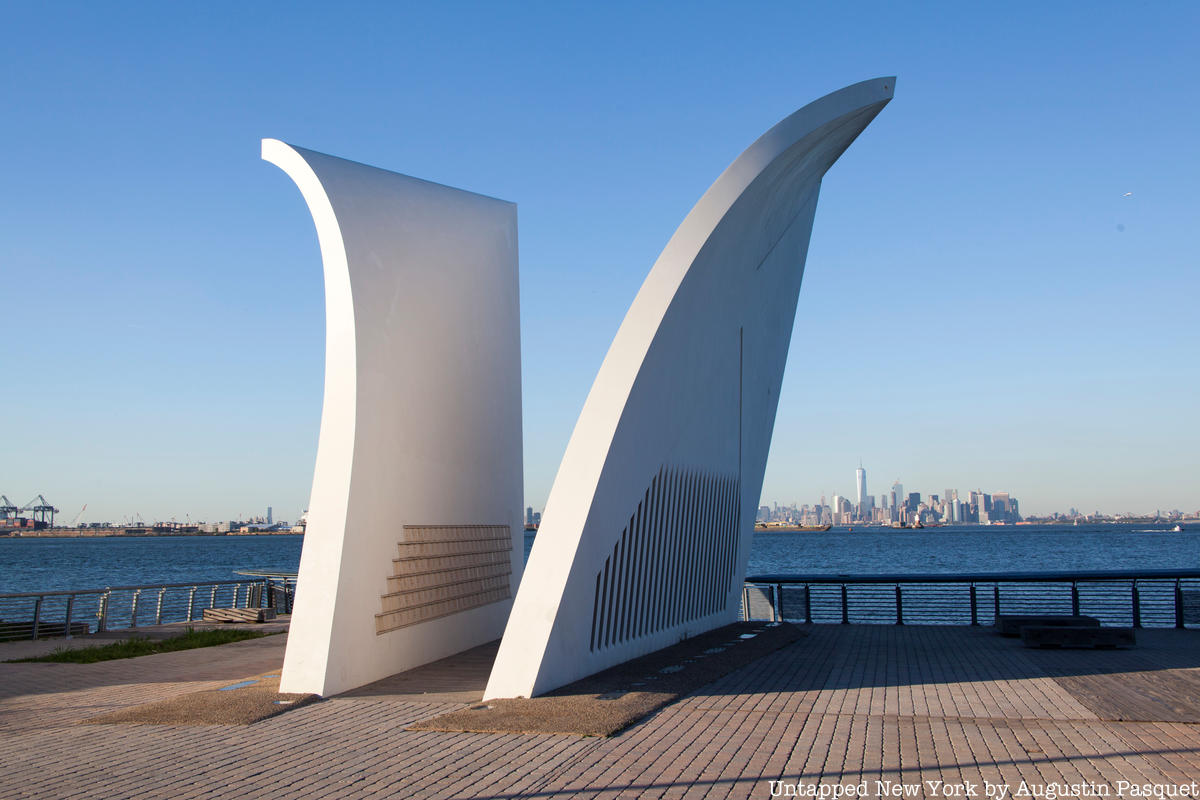
At the beginning of a normal month, we would have presented the new art installations not to miss in New York City. For obvious reasons during the coronavirus crisis, we are shifting the angle of that regular column a bit. New installations have been understandably postponed and New Yorkers should take care to keep social distance — we are far from the end of the unprecedented pandemic situation. New York is on PAUSE, save for essential business, but Governor Cuomo still encourages solo exercise. Here, we present some of the many works of art you can still discover on your local run, which can be seen when you get your outdoor activity time. Here we have selected some of our favorites, two from each borough and one on Roosevelt Island.
1. Rocket Thrower in Flushing Meadows-Corona Park
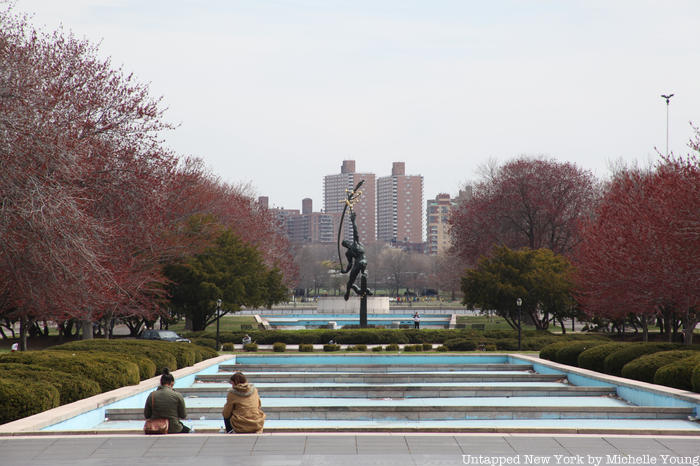
Flushing Meadows-Corona Park is the fourth largest park in New York City and a good bet to get space will taking in the outdoors at this time. While there, look for the Rocket Thrower, a a 43 foot-tall sculpture designed by sculptor Donald De Lue created for the 1964 New York World’s Fair. The sculpture depicts a god-like man launching a sphere into the sky with his right hand while reaching for the stars with his left hand. De Lue was one of five sculptors who were commissioned to create pieces by the Committee on Sculpture for the World’s Fair, choosing artists “from contemporary conservative to the more conservative avant-garde.” Upon creation, De Lue noted that Rocket Thrower was “the spiritual concept of man’s relationship to space and his venturesome spirit backed up by all the powers of his intelligence for the exploration of a new dimension.”
Made of bronze, the sculpture faced severe corrosion and was significantly restored in 2013 and is still looking spiffy. This year, the water feature in front of the Rocket Thrower will be restored by NYC Parks, adding patio space with lounge chairs and water features for children.
2. Postcards Memorial

Postcards is one of the many 9/11 tribute monuments in New York City. It’s located in the North Shore Waterfront Esplanade Park on Staten Island and dedicated to the Staten Island residents who lost their lives on September 11, as well as those in the 1993 World Trade Center bombing. The memorial, designed by Masayuki Sono, is consisted of two wing-like structures aligned towards where the Twin Towers once stood.
The 275 Staten Islanders are remembered with their own granite plaque engraved with their name, birth date, and a silhouette of their profile looking towards the site of Ground Zero.
3. The Passage, Staten Island Memorial Green
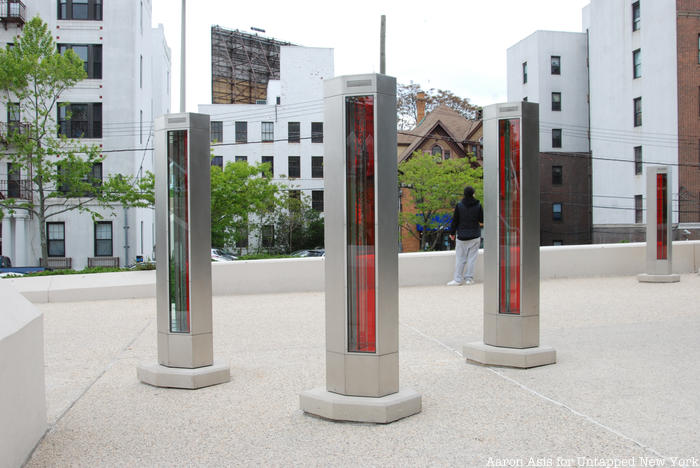
Situated right by Staten Island’s courthouses near the St. George Ferry Terminal, The Passage is an installation created by Mary Miss on the Memorial Green. The memorial commemorates immigrants who were quarantined and buried on the grounds of the Memorial Green. The installation tells stories of immigration through multi-faceted steel and glass columns that stand six feet tall. On one side of the column is a ruby red piece of glass that gives off a bright red glow, which becomes further accented at night. Each column tells stories of immigrants settling in New York following catastrophic events like the Irish Potato Famine, and the inside of each column is lined with mirrors which allows for a kaleidoscope-like display. Glass panes as part of the project are also found at the Staten Island Ferry Terminal and on some ferry windows.
According to the project’s booklet, “The ride on the Staten Island Ferry is turned into an opportunity to follow the experiences of immigration: stories of departure, crossing and arrival are sequenced from Manhattan, to the ferry, to the Staten Island Terminal, to the Memorial Green. This is a unique opportunity to reveal glimpses of the experience of immigration as a journey rather than through the static experience of being inside a museum.”
4. East River Roundabout
 Photo courtesy Alice Aycock (there will be way fewer people there than at this event above).
Photo courtesy Alice Aycock (there will be way fewer people there than at this event above).
Right on the East River sits a mysterious roller coaster-like structure that many New Yorkers know little about. The sculpture, titled East River Roundabout, sits atop a former waterfront garbage transfer station and was creative by Alice Aycock in 1994. Supposedly, the sculpture was inspired by the weightlessness of Fred Astaire’s dancing. Recently, the public plaza where her piece is displayed was restored in 2018 by NYC Parks through the Municipal Art Society Adopt-a-Monument Program. and features new grass and plantings, tables, and chairs.
Aycock described her project as an “opportunity to galvanize this extremely dynamic situation, calling attention in a dramatic way to the visual forms of movement inherent in this very active place. The Roundabout is a theater around which New York City enacts itself. And the viewer becomes a spectator in the play of the city as well as an actor in the spectacle.”
5. Sculpture Dedicated to the Roeblings at Brooklyn Bridge
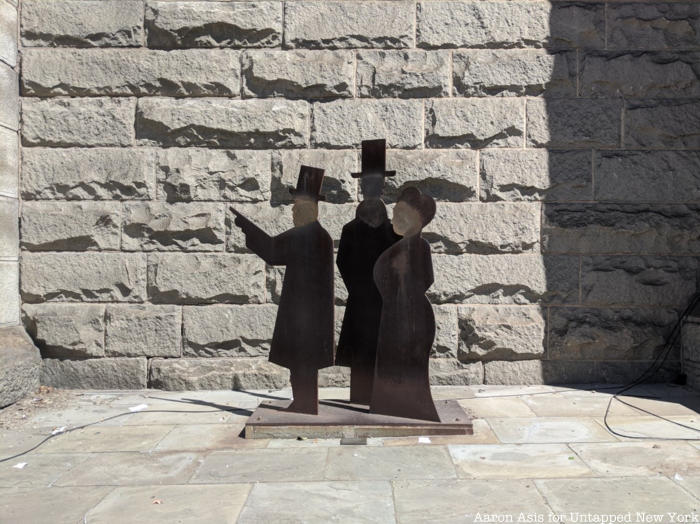
While normally, the Brooklyn Bridge is surely one of the most crowded places in New York City, these days its nearly empty. One of the little known things to look for its the sculpture in honor of the Roebling family, who designed and built the bridge. The sculpture is located at Anchorage Plaza on Old Fulton Street and Front Street.
In silhouette, you’ll find Emily and Washington Roebling, and Washington’s father John Roebling the original designer of the bridge. Father and son would die in connection to the construction and when Washington came down with the bends, Emily completed the project.
6 & 7. Pelham Bay Park Sculptures

Pelham Bay Park in the Bronx contains two noteworthy sculptures that tower over parkgoers: the Bronx Victory Memorial and American Boy. The American Boy, designed by French-born artist Louis St. Lannes, was cast in 1932 and depicts a male youth inspired by Archaic Greek architecture. The sculpture was originally part of a classically styled stadium with decorative Olympics-inspired friezes, yet as the structure deteriorated, the stadium was deemed a safety hazard and was subsequently demolished in 1989. Like the Bronx Victory Memorial, American Boy was also subject to vandalism and erosion, yet the sculpture was restored in 2002.

The Bronx Victory Memorial was designed by landscape architect John J. Sheridan and sculptors Belle Kinney and Leopold Scholz in 1932. The memorial commemorates the 947 soldiers from the Bronx who died in World War I and sits adjacent to a Memorial Grove of trees, which is a beautiful walk. The namesake “Lady of Victory” measures 18 feet in height, poised atop a stone globe at the top of a 70-foot column. Limestone reliefs at the bottom of the statue depict regiments of soldiers marching into battle.
8. Tom Otterness in the East River off Roosevelt Island
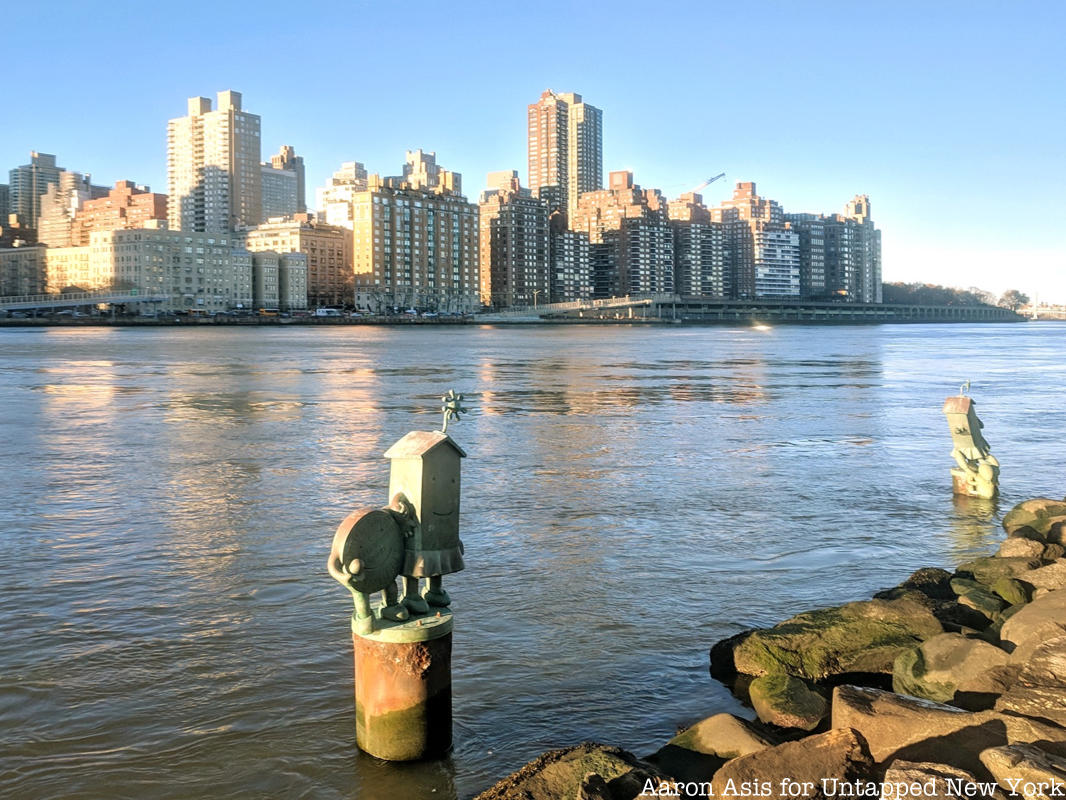
While walking along the water’s edge on Roosevelt Island, you may notice little green sculptures poking out of the East River. Installed in 1996, these sculptures comprise Tom Otterness’ “The Marriage of Money and Real Estate,” symbolizing wealth inequality within New York City.
This series of three sculptures depicts rather comedic scenes of a coin being attacked by a man in a top hat, a lobster with a dollar sign attacking a house in a skirt, and a house and a coin joined in marriage. Otterness’ whimsical work is also displayed in New York locations like in the 14 Street-8th Avenue subway station. While walking around Roosevelt Island, also check out the smallpox hospital and see our photos from inside!
9. Green-Wood Cemetery’s Civic Virtue
 Civic Virtue in its newest home in Green-Wood Cemetery
Civic Virtue in its newest home in Green-Wood Cemetery
The Civic Virtue Triumphant Over Rightousness statue may have been the city’s most controversial in history, prior to the push to add more female figures. The allegorical piece was commissioned in 1909 and installed in 1922 and installed in Manhattan’s City Hall Park, as part of a fountain. The statue is 22 tons of marble carved from a single block, meant to represent the triumph of virtue over corruption and vice.
The problem: the nearly naked male figure is triumph, towering and dominating over the two female mermaids who represented corruption and vice. Women found this misogynist and offensive, and even men thought it looked like the virtue was kicking or trampling the female figures. By 1929, James J. Walker, the Commissioner of Public Works was calling the sculpture “the Fat Boy standing in a mass of worms,” and advocated for its removal. The statue was finally moved in 1941 to Queens Borough Hall. It was not well-liked in Queens either, with Anthony Weiner even suggesting to sell the statue on Craigslist.
In 2011, Green-Wood Cemetery President Richard J. Moylan offered to give the statue a home in the cemetery. By early 2013, Civic Virtue was placed among other statues by sculptors contemporary to MacMonnies, like Daniel Chester French and John Quincy Adams Award. The cemetery even funded its renovation. After 90 years, Civic Virtue seems to have found its resting place. The fountain portion remains, however, along Queens Boulevard. Green-Wood Cemetery has recently expanded the opening days of its entrances, so now the entrances at Fort Hamilton Parkway and Prospect Park West Entrances that used to be only open on weekends are open seven days as week (and of course the main entrance).
10. Tom Fruin’s Watertowers
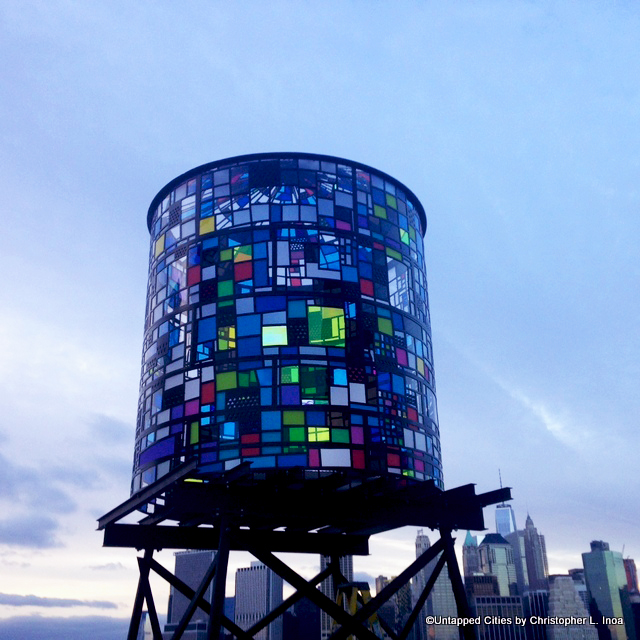
Using over 1,000 scraps of plexiglas, artist Tom Fruin created a number of rooftop watertowers at locations like 20 Jay Street and 334 Furman Street, the latter of which is in Brooklyn Bridge Park. Fruin’s sculptures can be viewed from a number of vantage points such as in Dumbo, Lower Manhattan, and the Brooklyn Bridge. Fruin’s colorful works, often made from recycled materials, can be seen in cities like Prague, Copenhagen, and Milwaukee.
Fruin’s watertowers are in direct sight of the sun, making for kaleidoscopic light displays. His sculpture Watertower 3: RV Ingersoll is even illuminated at night due to the solar powered system provided by Lumi•Solair. Fruin’s style of artwork is described as ”where you take a lot of disparate material and you put it together to make a larger whole that’s something different.”
11. Socrates Sculpture Park
 Rock n Roll, Photograph by Scott Lynch, Courtesy of Socrates Sculpture Park
Rock n Roll, Photograph by Scott Lynch, Courtesy of Socrates Sculpture Park
Socrates Sculpture Park along the waterfront in Astoria, Queens is still open and the most recent exhibition there is the Socrates Annual, showcasing the work of a group artists who received the Socrates Annual fellowship. The commissions for the show are produced on-site in an outdoor studio over the course of the summer. The works selected engage the Park’s unique history, landscape, and the surrounding community.
For the 2019-2020 exhibition, projects range from a soundscape of the sounds of animals and man-made objects, to a monument to the invasive Ailanthus plant. Several artist projects examine storytelling, from an homage to a Native American myth in which North America exists on a turtle’s back, to a suggestion that a giant has fallen asleep under the Park’s blanket of grass, its exposed nose becoming refuge for a wandering monitor lizard.
Next, check out an interactive map of coronavirus cases by zip code. Also, discover 20 permanent art installations in Lower Manhattan.





